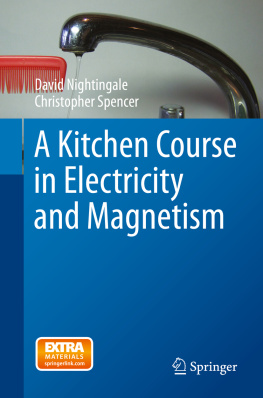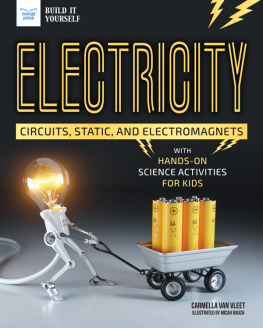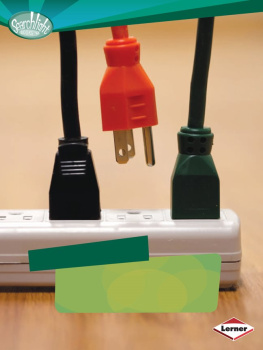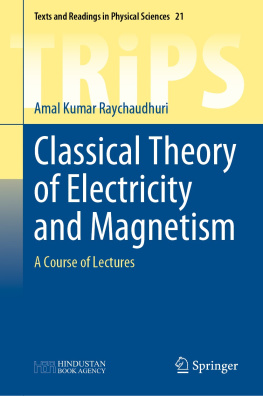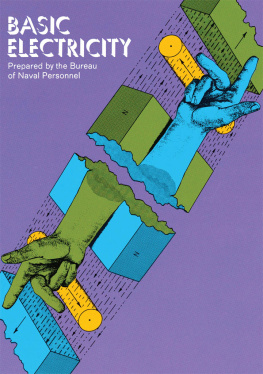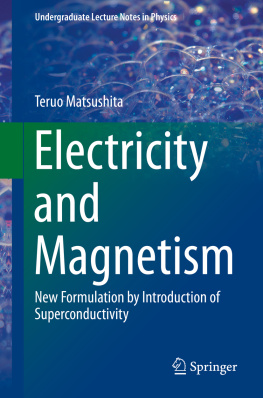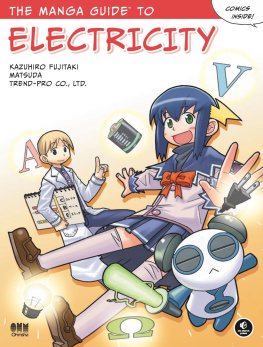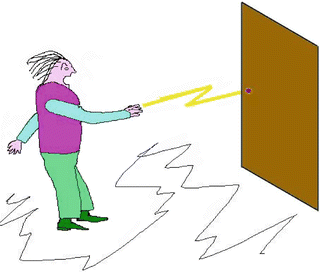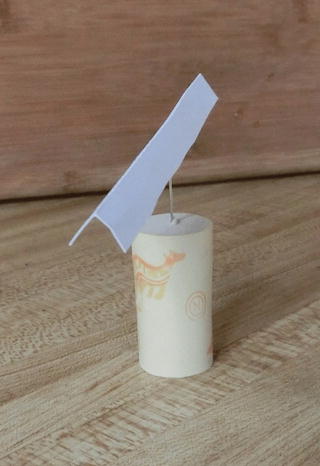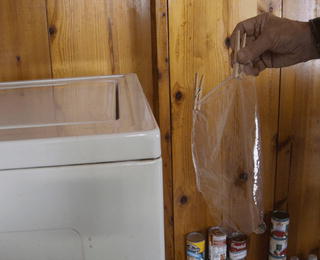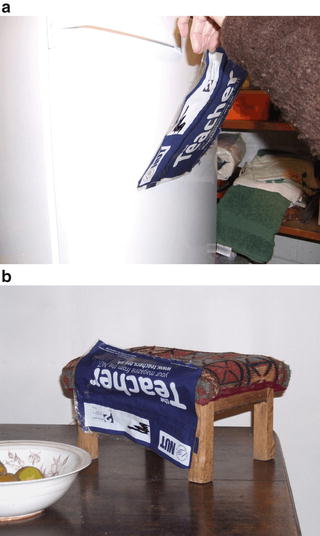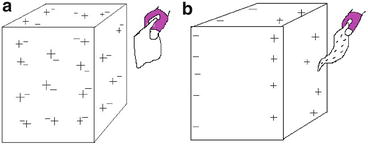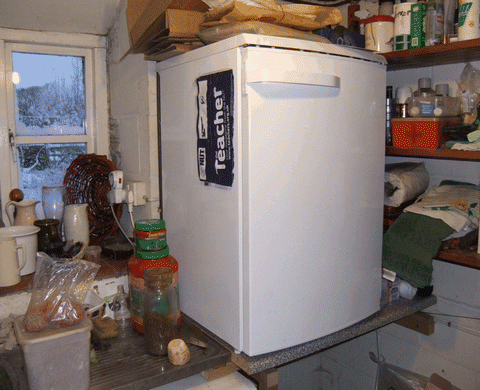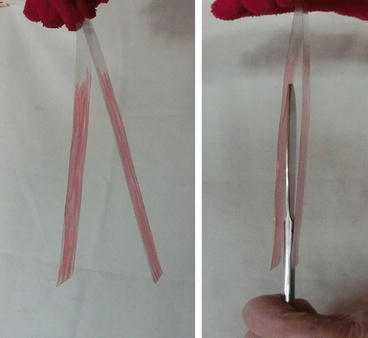1.1 Static Electricity
Everyone has rubbed a balloon on his/her shirt and watched the balloon cling to a ceiling, and maybe you have shuffled across a carpet on a dry day, only to receive a shock from the next thing touched. This particularly happens in winter, when the humidity is low.
Also, on a similarly dry day, you may have combed your hair and heard a crackling sound or touched someone and theres been a spark from your hand (Fig. ).
Fig. 1.1
Shuffling across a carpet and getting zapped
1.2 A Charge Detector
There are various ways to detect electric charge, and in Fig. we show a detector that can be assembled at home in a few minutes.
Fig. 1.2
A piece of thin cardboard is folded along its center and supported by a needle stuck in a cork. It will swing round towards any electric charge
We take a strip of thin cardboard, or sturdy paper, about 4"6" long, and fold it along its center line. We can then balance the cardboard at its center on a needle stuck in a cork, as shown.
If a charged balloon or comb that has been rubbed is brought near to either end of the charge detector, the cardboard will swing around and follow, clearly attracted, and never repelled. However, it is only a detector, and it will not tell us anything about the charge that is causing it to swing.
In the following pages we look at some different kitchen phenomena involving electrostatic charges and, after studying the atom, begin to explain them.
1.3 Using Plastic Wrap
In Fig. below, a piece of un charged plastic wrap hangs freely. The home experimenter will find it quite a challenge to have this uncharged, because normally, when plastic wrap is torn from its box, friction will give it a charge. In the photograph, the plastic was actually unrolled slowly and carefully, and cut with sharp scissors, avoiding friction or scraping.
Fig. 1.3
A piece of uncharged plastic wrap hangs freely
However, as we said, if it has been rubbed or torn off recently, it will be charged and will cling to almost anything, as shown in Fig..
Fig. 1.4
( a ) If the plastic has been torn recently, or dragged across a dry shirt or other cloth, it will cling to almost anything, such as the metal refrigerator or ( b ) perhaps a stool
1.4 What Has Happened
When the plastic was torn too vigorously from its box, electrons were knocked either off the surface of the plastic (leaving the plastic somewhat positive) or off the box and onto the plastic (thus leaving the plastic with an excess of electrons).
As yet we havent given any reason which of these it is. It would actually be possible later to find out, but for simplicity let us assume now that the plastic wrap is (), i.e ., too many electrons.
The plastic can cling to anything, because then (+) charges in various nearby objects will try to get close to the plastics ()from the results of those early experimenters who saw that unlike charges always attract each other and like charges repel .
Of course, the metal and/or the nonmetal stool were originally electrically neutral. So what was going on?
Consider the refrigerator first. In the left sketch of Fig. the plastic is neutral, as is the refrigerator. (For simplicity we have not bothered to show the equal number of pluses and minuses on the plastic, although they are shown on the refrigerator.) In the right-hand figure the () charges of the refrigerator have now moved as far away as possible from the () charged plastic wrap, leaving (+) charges nearer to the plastic wrap. Of course, there is then mutual attraction.
Fig. 1.5
( a ) Original uncharged plastic, ( b ) charged plastic
The refrigerator is made of metal, which is a conductor , and electrons are free to move in a conductor . We will take this as the definition of a conductor (and discuss semiconductors later).
In the case of the kitchen stool (see Fig. ), which is not a conductor but rather an insulator (we use the word insulator for a material whose charges are NOT free to migrate from one place to another) something has obviously happened that there is still attraction.
Note that in these kitchen experiments the plastic wrap may eventually lose its attraction because some of the charges on the surface of the plastic may very slowly get neutralized, perhaps by actual contact with the metal refrigerator, and/or from stray atoms in the air that may have lost or gained an electron. (Such atoms and/or molecules are called ions .)
Our Fig. shows a piece of charged plastic still clinging to the side of a metal object after many days!
Fig. 1.6
Plastic wrap still clinging weakly. (This has been here for over 3 months !)
1.5 Experiment: Two Plastic Strips
Cut two strips of plastic, as shown in Fig.. Its best if these have a certain rigidity, and we have colored them only so as to render them visible against the white background.
Fig. 1.7
The charged strips repel each other, but if a conductor is brought between them they will collapse onto it. When the conductor is removed, the strips repel each other once more
Rub them all the way down with your bare fingers or with a sock or some kind of wooljust once or twice; this will make the strips, which are identical, repel each other, as on the left side of Fig..
Next, bring up a kitchen knife, or some metallic object, between the strips and witness them both collapse onto the metal, as on the right of Fig..
Take the knife away, and they will go back to repelling each other again.
1.5.1 What Is Happening
The plastic is an insulator (defined on p. 4). By friction some charges were knocked off.
There must be like charges on the two pieces of plastic for them to repel.
When a conductor is brought between them the opposite sign of charge is attracted as close as possible to the charges on the plastic strips. Thus each strip is attracted to the metaland clings to it.

